 |
|
Christopher Wood – who
died in 2015 – was one of the more intriguing and erudite figures to have
been associated with the writing of the James Bond film series – in an
interview conducted in 2011 and now published for the first time.
LUKE G.
WILLIAMS put the questions and Wood supplied the answers, in his
characteristically witty and inimitable fashion. |
|
Lambeth-born, the
Cambridge educated Christopher Wood enjoyed an eclectic life and career,
encompassing historical fiction, humorous erotica … and James Bond.
An advertising executive turned writer, Wood’s screenwriting work on the
Roger Moore/Lewis Gilbert epics The Spy Who Loved Me (1977) and
Moonraker (1979) is, for many Bond fans, secondary to his polished and
impressive work on the novelizations of these two films, the accomplished
and ‘Fleming-esque’ style of which puts many of the 007 ‘continuation’
novels by more ‘reputed’ authors to shame.
Kingsley Amis, whose excellent
COLONEL SUN stands, in this writer’s estimation, just ahead of Wood’s
JAMES BOND, THE SPY LOVED
ME as the finest continuation novel, reviewed Wood’s work on this book
thus in The New Statesman:
“Mr. Wood has bravely tackled his formidable task, that of turning a
typical late Bond film, which must be basically facetious, into a novel
after Ian Fleming, which must be basically serious. To this end he has, by
my count, left out nine silly gadgets and sixteen silly cracks which were
in the script. He has also left out, to my surprise, a marvellous fight on
a train that challenges comparison with the one in ‘From Russia With
Love’. The heavy concerned, a seven-and-a-half-footer with steel teeth,
name of Jaws, is the best thing in both book and film. Mr. Wood is not
always exact: Bond, out skiing, muses that you “can lay for a long time in
the bottom of a crevasse” – I doubt if even Bond could manage more than a
brief lay in such circumstances. But the descriptions are adequate and the
action writing excellent.” |
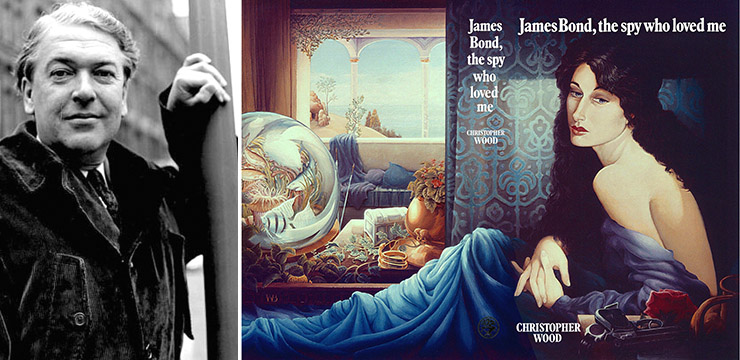 |
|
ABOVE: (left)
Kingsley Amis (1922-1995) author of COLONEL SUN (1968) reviewed
Christopher Wood's JAMES BOND, THE SPY LOVED ME very positively in
The New Statesman in 1977. (right) Wraparound dust jacket
artwork by British illustrator, designer and artist Bill Botten
(born 1935) for the hardcover first edition of JAMES BOND, THE SPY
WHO LOVED ME (1977) published by Jonathan Cape. |
|
|
|
From a harsh critic such
as Amis the above comes close to a rave review. Indeed, when he came to
review John Gardner’s
LICENCE RENEWED a few years later, Amis was in particularly
vituperative form.
Aside from his work on the Bond films, Wood is probably best remembered
for his work on the hugely successful ‘Confessions’ series of humorous
erotic novels and films, under the pseudonym Timothy Lea.
Due to his high-profile association with James Bond and the ‘Confessions’
series Wood’s literary output has often been overlooked, but it certainly
deserves a reappraisal, particularly his rollicking 2004 effort
California, Here I Am, set in Hollywood, and his second novel, 1970’s
‘Terrible Hard’, Says Alice, which was inspired by Wood’s time
doing national service in Cyprus.
Wood’s account of his time on the Bond series, James Bond. The Spy I
Loved
(2006) is also an extremely entertaining read, chock-full of witty
one-liners e.g. “The telephone rang and, grateful for the exercise, I
reached out and answered it.” |
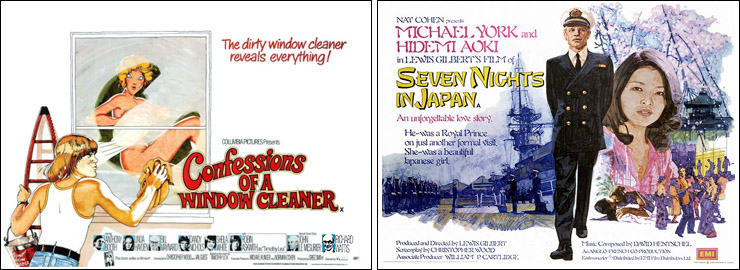 |
|
ABOVE: (left) The UK
quad-crown poster for Confessions of a Window Cleaner, a
1974 British sex comedy directed and co-written by
Val Guest
(1911-2006), who had earlier been one of the five directors (and
additional sequences) of the 1967 James Bond spoof
Casino Royale.
Confessions of a Window Cleaner was the first of a series of
four films chronicling the erotic adventures of Timothy Lea, based
on the novels written under that name by Christopher Wood. Like
the ‘Carry On’ series, the ‘Confessions’ films were cheap to
produce but commercially successful at the box-office, featuring a
host of fading British character actors at the end of their
careers. The poster was painted by English designer Vic Fair
(1938-2017), whose 1985 design (painted by
Brian
Bysouth) of Roger Moore as James Bond in a white tuxedo with a
stylized illustration of May Day (Grace Jones) was deemed
unsuitable to promote A View To A Kill, and only issued as
a commercial poster. (right) Seven Nights in Japan (1976)
is a largely forgettable British drama about fictional British
Royal Prince George, who travels to Japan and falls in love with a
local female tour guide named Sumi. Directed by
Lewis Gilbert,
the film features several James Bond film alumni including
Charles Gray,
James
Villiers, and Anne Lonnberg, who played the Venice museum
guide – one of Drax's girls – in Moonraker (1979).
John Glen
was the editor,
William P.
Cartlidge the Associate Producer, and featured the final
screen performance by Val Guest's actress wife Yolande Donlan
(1920-2014). The UK poster art was by Italian designer Arnaldo
Putzu (1927-2012), who also painted Roger Moore (seen in the
header at the top of this page) for the cover of several issues of
the popular children's magazine
Look-In.
BELOW: Notable works
by Christopher Wood – ‘Terrible Hard’ Says Alice
(1970); The Further Adventures of Barry Lyndon by Himself
(1976) historical fiction: a sequel to The Luck of Barry Lyndon
by William Makepeace Thackeray – Christopher Wood's name does not
appear on the cover; Fire Mountain (1979), and
California, Here I Am (2004). |
|
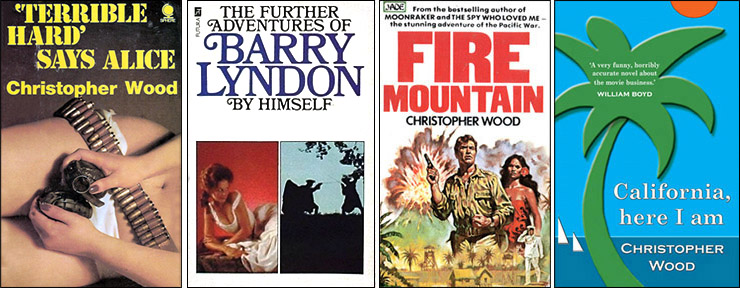 |
|
|
Sadly, Wood passed away
in May 2015, aged 79, but just over four years earlier I was fortunate
enough to interview him via email about his experiences on The Spy Who
Loved Me. For some reason we never followed up, as planned, with an
interview about his work on Moonraker, which was doubtless my
fault, and which I regret enormously.
Courteous to a fault and extremely witty, Wood struck me – even via such
an impersonal medium as email – as being an extremely pleasant and
intelligent man.
It's a correspondence and interview that has never before been published –
until now…
What follows are the emails we shared, as well as Christopher’s answers to
the questions I asked… |
|
FROM: LUKE WILLIAMS
Dear Christopher,
Thank you for taking the time to answer my questions about The Spy Who
Loved Me – and for your Bond movies having given me so much excitement
and pleasure over the years! I’ve just spent a very enjoyable day
re-reading your novelization of TSWLM – which I have to say I put right up
there alongside Kingsley Amis’ COLONEL SUN as the only ‘non-Fleming’ Bond
novel worthy of a place alongside the Fleming originals.
Anyway, here are my questions!
Best wishes and thanks again!
Luke Williams.
|
|
FROM: CHRISTOPHER WOOD,
12/4/2011
Dear Luke Williams (Hmn. Good name for an action hero. I might use it one
day)
The answers to many of your questions are to be found in the ‘brilliant’,
‘delectable’, ‘essential reading’ – I quote reviews: James Bond, The
Spy I Loved (Twenty First Century Publishers Ltd, 2006) by – oh, yes –
me.
Anyway I will do my best to respond. Please remember that though it still
seems like yesterday it was in fact 35 years ago and my memory may be
fading.
As I said before, if you really want more detailed info, read James
Bond, The Spy I Loved. I am glad you appreciated the novelization. You
are not alone and that gives me pleasure. Good luck with the article. I
look forward to reading it.
Christopher Wood. |
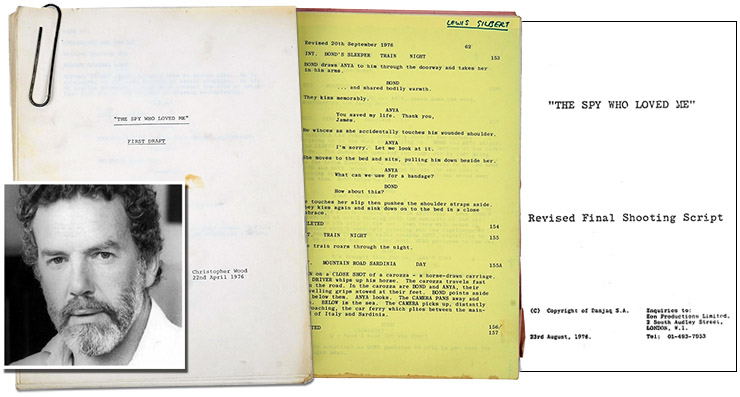 |
|
ABOVE: Scripting on
The Spy Who Loved Me began as early as 1975 when the
original director Guy Hamilton was still attached to the project.
Unable to use Ian Fleming's original storyline, EON Productions
approached English novelist Anthony Burgess (1917-1993), American
screenwriter Stirling Silliphant (1918-1996), and American
filmmaker John Landis (born 1950) among others. All of these
drafts proved unsuitable and a number of other writers were
commissioned to work on the script, including Lewis Gilbert, who
had returned to the series after a 10-year break when Guy Hamilton
left the production after he was engaged as the original director
of Superman The Movie (1978). Up to 14 different writers
had allegedly contributed to the script when Gilbert chose
Christopher Wood to come up with a storyline. Wood's ‘First Draft’
(left) was dated April 22, 1976 – but was further revised by
long-time 007 screenwriter
Richard
Maibaum, who both share credit for the finished screenplay.
(centre) The copy of Lewis Gilbert's script with a revised page
dated September 20, 1976 showing new dialogue for the scene
between Bond and Anya, who share a train compartment as they
travel to Sardinia. (right) The original revised final shooting
script was dated August 23, 1976, but continued to be changed
until filming was completed in January 1977. |
|
|
|
How did you get the
opportunity to write the screenplay for The Spy Who Loved Me? Were
you already a Bond fan when you took on the job?
I wrote Seven Days in Japan for Lewis Gilbert and when casting
around for, yes, yet another writer he thought of me. I had enjoyed all
the movies and read most of the books.
When you were hired what ideas for the screenplay were already in
place? What guidance did EON give you in terms of the tone of the
screenplay they wanted?
I think there had been many screenplays and writers and it was desperation
time when I came on board. Jaws was there but the story was totally
different and, I thought, suffered from trying to be too original.
I wanted to go back to basics, to things that Bond fans expect and enjoy.
Yes, there was a lot of pressure, not helped by the Kevin McClory lawsuit
(at one point I began to wonder if I had been hired to take the rap. See
James Bond, The Spy I Loved) and the fact that United Artists
initially preferred the original(s) to the final draft I handed in!
However, Lewis Gilbert is a good man to work with, calm relaxed, and an
agreeable dinner companion, and ‘Cubby’ and Michael Wilson were never less
than supportive regardless of what was going on beyond behind the scenes.
I enjoyed it. Being closely involved in a Bond movie is like being
Bond. You thrive on the buzz.
My guidance came from Lewis. We agreed that Roger should not try and be
Sean but be himself. Bond should be Roger. I tailored dialogue and
situations to Roger’s strengths. I was against him pumping the villain
full of bullets at the end of the movie. Sean could do this. It did not
seem right for Roger. Roger is a one-bullet man.
Can you recall any ideas that you were disappointed (or relieved!)
didn’t make it into the final screenplay?
I think, even then, that Bond on a water ski [sic. jet-ski] seemed a bit
hokey. |
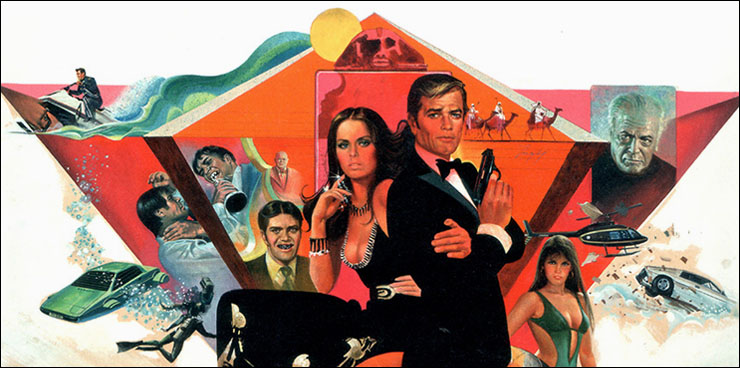 |
|
ABOVE:
Robert Peak's
iconic artwork for The Spy Who Loved Me (1977) was often
repainted for use on posters in different countries. In this
instance the design has been enhanced with the addition of other
characters and action by prolific Thai artist Tongdee Panumas
(born 1947), who signs his posters with just his first name. |
|
|
|
Can you recall how
many drafts of the screenplay you worked on, and how long you were on the
film for?
Lots of drafts and tweaks and perhaps two months on the movie. Can’t
really remember.
Your novelization of The Spy Who Loved Me is very different from
the final film and very close to Ian Fleming’s original writing style. How
did you approach writing the novelization? It seems to me you get the tone
just right – it’s reminiscent of Fleming without straying into pastiche.
I reread a couple of the Bond books and enjoyed turning myself into a
Fleming Bond. EON were not involved and I think the novelization was just
another marketing tool as far as they were concerned. I wrote the book
pretty quickly over a skiing holiday. I had to.
What scene or character in The Spy Who Loved Me screenplay are
you most proud of? What lines of dialogue were you most proud of?
I think the Bond/Anya relationship works well and the scene before she
puts him to sleep has charm. I like Bond’s ‘How long can we go on meeting
like this?’ and ‘All those feathers and he still couldn’t fly.’ These
tumble into my mind after all those years. |
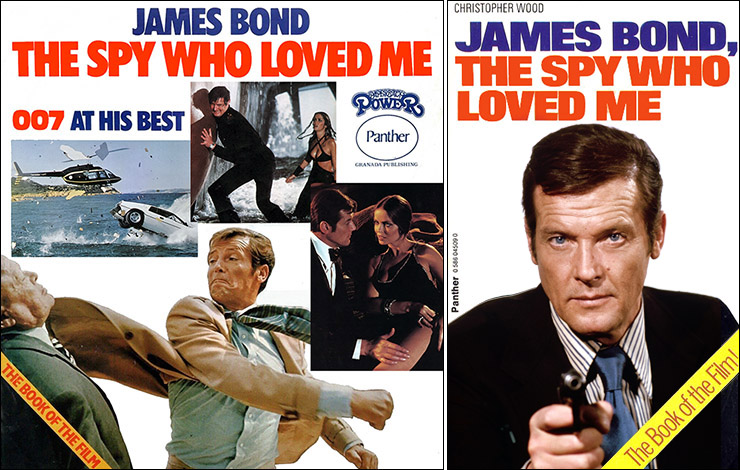 |
|
ABOVE: (left) A
poster promoting the Australian film tie-in paperback release of
Christopher Wood's novelization of his screenplay for JAMES
BOND, THE SPY WHO LOVED ME (1977). (right) The UK
Panther Books paperback of JAMES BOND, THE SPY WHO LOVED ME. |
|
|
|
At what stage was it
decided that Jaws would survive, rather than perish, at the end of the
film?
I think it was ‘Cubby’ who, astutely, decided to leave it open as to
whether Jaws perished at the end of the movie. Public reaction was
positive so… back he came. I had a much darker and one-dimensional vision
of Jaws. I think it must have been Lewis who watched the rushes and
perceived that this brute had a clumsy, touching, human side that made him
a richer character.
What was the most enjoyable aspect of writing the screenplay for The
Spy Who Loved Me?
As a screenwriter, you never know whether the movie you are working on
will be made – unless it is a Bond movie. I have a shelf full of great
characters, words and scenes that will only survive as tightly bound
fading print.
Can you recollect how the pre-credits ‘ski jump’ scene came to be
written and conceived? Did you meet
Rick Sylvester, who performed the
legendary jump?
‘Cubby’ saw an ad in which Rick ‘performed’ the stunt. In fact, he didn’t
but said that he could. (see James Bond, The Spy I Loved for
details). Can’t remember if I met the guy. Obviously, it was not earth
moving.
Do you have any memories of
Ken Adam and his incredible work on The
Spy Who Loved Me?
I saw the ‘Supertanker’ set being constructed. Ken’s sets are great – and
expensive – they set the writer a problem. Something that costly must
absorb a large amount of screen time to justify the outlay. Thus, the
writer is obliged to dream up lots of action in a static environment. Also
see the Space Station in Moonraker! |
